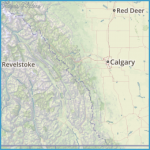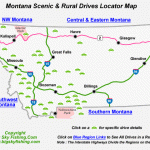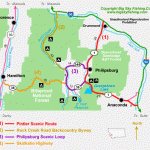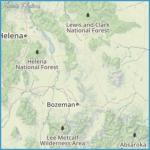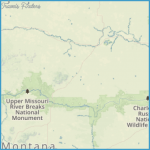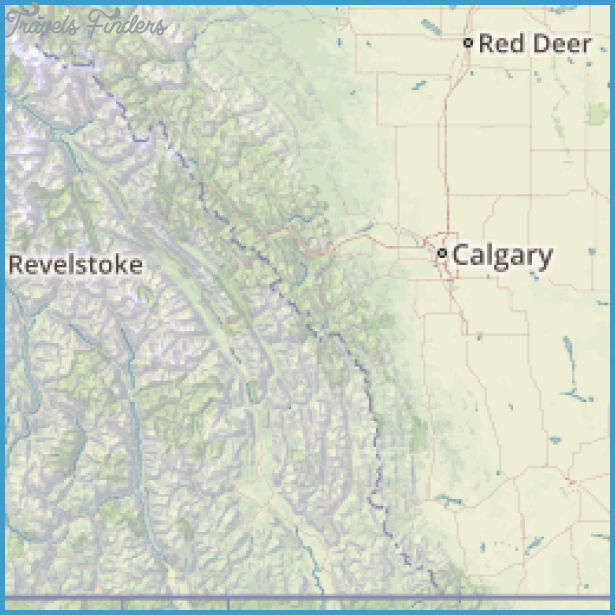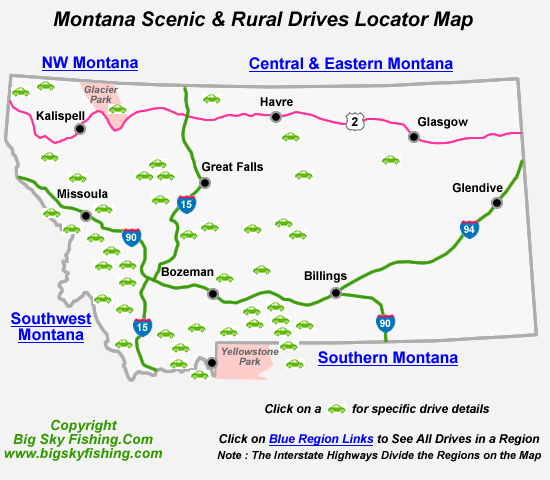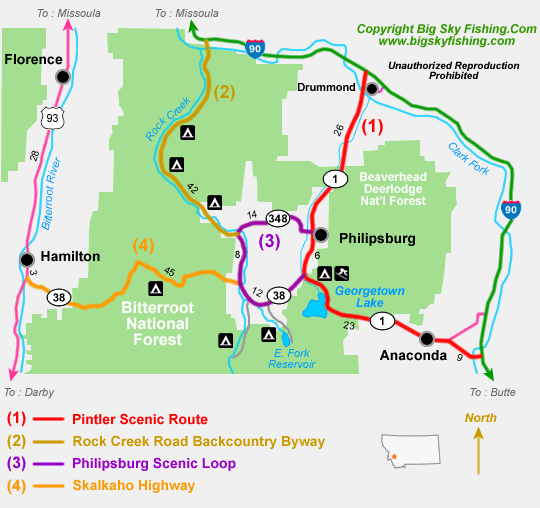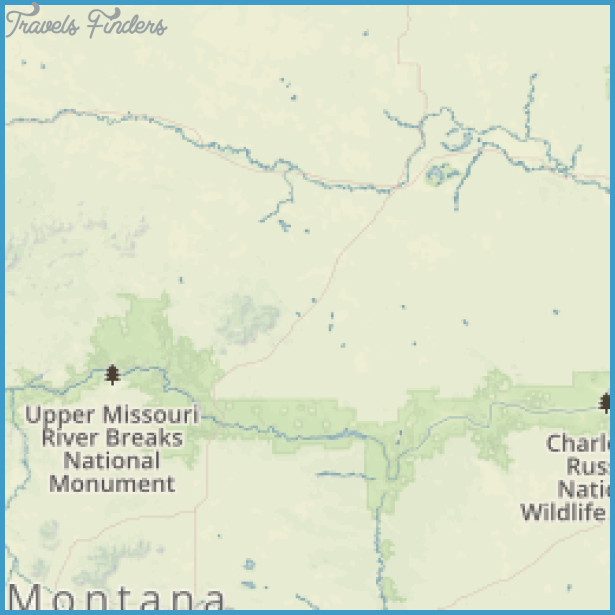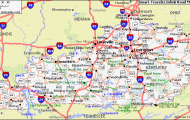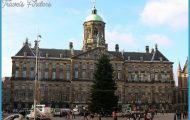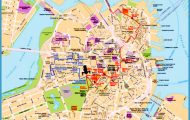Estimated length: 88 miles estimated time: 3 hours to 2 days
Highlights: Museums, hot springs, Berkeley Pit, Old Works Golf Club, Georgetown Lake, Philipsburg, Discovery Ski Basin, Ohrmann Museum & Gallery, Grant-Kohrs Ranch
Getting there: The Anaconda-Pintler Scenic Route begins and ends at I-90 in southwest Montana. From the east, leave the freeway at the Anaconda-Opportunity turnoff (Exit 208) about 15 miles west of Butte and continue for another 6 miles to Anaconda. From the west, take Exit 155 off I-90 at the little ranch and railroad town of Drummond and head south along Flint Creek.
OVERVIEW
Montana’s prolific mining past comes to life along much of this drive through thick conifer forests around one of the state’s most rugged mountain ranges. The forests are so dense here that it’s hard to imagine you’re surrounded by the wild shoulders of the Flint Creek Range, which rises to nearly 11,000 feet. Just as prominent as the mountain range is the mining history, which fills your windshield the moment you turn off I-90 at Anaconda. A ghostly smelter stack the tallest man-made structure in Montana rises from the mouth of Dutchman Creek. In its heyday, Anaconda was a gritty town of rugged Irish-Catholics whose fortunes ebbed and flowed with the production of copper and gold from the cavernous mines at nearby Butte. This area once produced more copper than any place in the world.
The mines having played out three decades ago, today the communities along the Anaconda-Pintler route are reinventing themselves as tourist towns exploiting their unique histories. The same holds true for Philipsburg, which has become an enclave of museums and theaters celebrating a lively past. Midway through the journey is Georgetown Lake, popular for fishing, snowmobiling, and summer cabins.
Donna Mitchell
TELLTALE TAILINGS AT THE BERKELEY PIT IN BUTTE POINT TO THE TOWN’S MINING GLORY DAYS
Once upon a time, Butte was a collection of ethnic communities Italians, Austrians, Finns, Slavs, Mexicans, and, of course, Irish where grimy workers poked underground for gold and silver in a mile-high bowl west of the Continental Divide. With the advent of electricity came the need for copper, and large quantities were excavated in the late 1800s. By the early 1900s, the population had swelled to more than 100,000 hard-working, hard-drinking, hard-brawling residents who spent their paychecks on booze and brothels in an area of town called The Line. The landscape literally changed in the mid-1950s, when the Anaconda Copper Mining Company dug the massive Berkeley Pit for which Butte is renowned or perhaps infamous. Entire communities vanished under the toxic slag.
Mining in the giant hole lasted for about three decades, until the 1980s, when operations ceased. Since then, the Berkeley Pit has been filling with toxic water. For a time it appeared that not even Our Lady of the Rockies, a bleached 90-foot-high lighted statue that stands guard over Butte from a high mountain atop East Ridge, could save a declining city. Yet Butte somehow endures and perseveres. Today it’s capitalizing on its past with popular uptown tours. It’s now one of the largest National Historic Landmark Districts in the nation and it even makes money charging tourists to look into its giant hole filling with water.
HITTING THE ROAD
This scenic route starts in Anaconda in the state’s eyes, but we suggest you begin in Butte (pop. 33,892) a town so proud of its mining origins, ethnicity, and grit that it has its own license plates that state, immodestly, Butte America. Once the butt of old FBI jokes and derided as the ugliest city this side of Gary, Indiana, today this brick-and-mortar town, rising to the lip of the gaping Berkeley Pit and sprinkled with classic mining head frames, emits a certain raw character and rock-ribbed charm
Places to see while in Butte: The Copper King Mansion (406-782-7580, May-Sept.) with guided tour, the World Museum of Mining (406-723-7211), and the Mineral Museum (406-496-4172). For a glimpse of Butte’s rambunctious past, don green garb and be there on St. Patrick’s Day, when 30,000 residents and visitors take to the streets. After yet another year of scratching out a living and surviving the cold of winter, the city unleashes its pent-up inhibitions with a party as wild as Mardi Gras or Carnivale, but with a certain Montanan flair. Don’t be surprised to see brawling patrons come tumbling out of any number of imbibing establishments. And unlike in many modern frontier towns, these fights aren’t staged. Another rowdy annual event is Knievel Days, named for one of Butte’s favorite sons and a magnet for up to 50,000 bikers each July. Another one to mark on your calendar: The Montana Folk Festival in early July. Wander from venue to venue and from food vendor to food vendor for a rollicking good time against a backdrop of mountains and headframes twinkling with red lights. ust over the hill off I-90, tucked into a gap in the mountains south of the freeway, is the former company town of Anaconda (pop. 9,329). It’s easily recognized from a distance by the 585-foot smelter stack on the edge of town, the world’s largest freestanding structure when built in 1919. The Stack, as it’s known by locals, is now a state park, but not open to visitors. This was where the ore mined in Butte was processed, and until Anaconda Copper’s purchase of mines in Mexico and Chile, no smelter in the world produced more copper.
If you’ve got kids in tow, consider taking a side trip between Butte and Anaconda to the Fairmont Hot Springs ($$$, 406-797-3241/800-332-3272), a large hotel and golf complex in the country with two mineral hot pools and two Olympic-sized swimming pools. Don’t go expecting peace and quiet, though: Fairmont is full of kids squealing with delight. Take Exit 211 from I-90, drive about 3 miles to the resort, then go north on County Road 441 to the junction of MT 1 at Opportunity. The hot springs are at the foot of the state-owned, 56,000-acre Mount Haggin Wildlife Management Area, the state’s largest wildlife area and ideal habitat for pronghorn, white-tailed and mule deer, elk, moose, and an occasional black bear. Another off-the-beaten-byway option worth the 10-mile drive is Lost Creek State Park (406-542-5500), featuring the 50-foot Lost Creek Falls and 1,200-foot limestone cliffs. The park is known for its mountain goats and bighorn sheep, which have bounced back from a lethal pneumonia epidemic in 2010. To get there, turn north on County Road 273 near the junction of MT 1 and MT 48, go left 2 miles later on Forest Service Road 683, and drive about 7 miles.
Anaconda is a long, narrow community, called An-da-CON-ta by residents. Back in the heyday, copper king Marcus Daly built an amusement park here; what’s left is the simple Super Copper Chute in Charlotte Yeoman Martin Park, a free 140-foot slide the kids might enjoy. The town’s fortunes fluctuated wildly with the copper industry, and when the smelter was shut down in 1980, the community was devastated. The weariness still shows, though as the cleanup of mining messes forges ahead there are efforts to reinvent Anaconda, a la Butte. The Old Works Golf Club (406-563-5989), marked by rusted mining equipment, was designed by Jack Nicklaus and is considered one of the outstanding courses in the country. It was built on the site of a dismantled smelter, and some of the ruins are visible from the course. The stately Hearst Free Library (406-563-6932) is another masterful example of century-old architecture. The library was created and then packed with books and art by infamous newspaperman William Randolph Hearst’s mother, Phoebe, who developed an abiding affection for Anaconda during visits to Montana. The library has been a community gathering spot since 1898. If you’re here in the evening, take in a movie at the ornate Washoe Theater (406563-6161), an art deco palace built in 1931 and once chosen as the fifth most beautiful theater in the nation by the Smithsonian Institute.
Anaconda’s motto is Where Main Street Meets the Mountains, and that’s just what happens as you head west on the officially designated Anaconda-Pintler Scenic Route. MT 1 weaves upstream along Silver Creek for about 15 miles before reaching Silver Lake, and then goes over a small divide to Georgetown Lake, a popular 3,000-acre summer and winter playground squeezed between the Flint Creek and Pintler ranges. Boaters ply these waters, usually in pursuit of landlocked kokanee salmon or football-shaped rainbow trout. The lake has a marina, four boat ramps, three national forest campgrounds, and numerous vacation cabins tucked into the pines. This is a snowmobiler’s paradise, and 5 miles to the north is Discovery Ski Basin (406-563-2184). The small ski area geared to locals is unique in that the green, blue, and black diamond runs are generally segregated instead of interspersed. Philipsburg skiers are thrilled at plans for a road to be punched directly from town to the ski area.
THE LEGACY OF SOUTHERN CROSS
Adso on a south-facing hill above Georgetown Lake are the remnants of one of the numerous ghost towns in the region and the one with perhaps the most extraordinary story: Southern Cross. The community, which sits at 7,000 feet above sea level, was born during the gold rush days of the Civil War and was a busy place for the first half of the 20th century. It had a store, schoolhouse, dance hall, saunas, post office and even had passenger rail service from Butte into the 1930s. Once the region’s gold- and silver-mining heyday ended in the early 1950s, many families, mostly Swedish and Finnish, remained at Southern Cross. One by one they passed away until, in 1991, the last of the old-time miners, a fellow named Little John Huttala, died. By then, though, a steady stream of eclectic newcomers had begun arriving, drawn by the lake and the isolation, eager to escape mainstream culture. They moved into the decaying, ramshackle homes scattered across the pine and aspen hillsides, and lovingly renovated them. They paid little or no rent to the long-departed Anaconda Mining Company, which even built a stunning wood and stone church, St. Timothy Memorial Chapel, for the hardy holdovers.
The new residents were basically squatters, so when a new company bought the rights to the leases in 1988, the owners initially wanted them all evicted. But few departed. In a happy ending to the story, after three years of wrangling, Magellan Resources allowed the residents to lease the homes for $150 per year. Today, the number of year-round residents at Southern Cross is estimated to range from three to five, and many of the old homes are boarded. But the handiwork of those who restored the community is evident, and, thanks to Georgetown Lake, the community is a busy curiosity revolving around events at St. Timothy. There’s even a St. Timothy Summer Music Festival held for five Sundays every summer beginning in late June and ending in early August.

